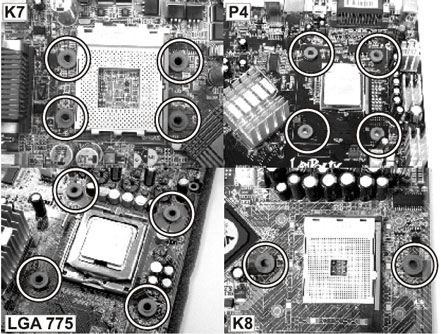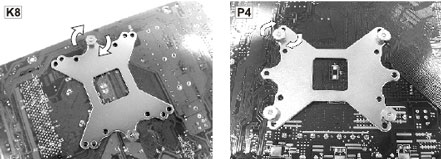Cooler Master Hyper 6+: Universal Heatpipe Tower
by Wesley Fink on February 14, 2007 12:02 AM EST- Posted in
- Cases/Cooling/PSUs
Cooler Master Hyper 6+
The Cooler Master package provides a good view of what you will get with the Hyper 6+. The cooler itself is featured in an acrylic clamshell that showcases the copper base, the aluminum heat fins, and the 6 heatpipes.

Cooler Master ships the Hyper 6+ with a 100mm fan, but it is not mounted. This allows you to clearly see a few of the tower design features

This includes the serrated fin design which significantly increases the surface area of the fins. The hybrid copper and aluminum base is also distinctive, using copper for the CPU plate and cast aluminum fins for first-stage cooling.

Heat is moved from the copper base to the fin tower with six copper heatpipes. The design mounts three pipes on each side of the tower and attaches the serrated fins to the heatpipes to remove heat.

Early designs of this cooler used a powerful and somewhat noisy 100mm fan. The current shipping fan does not move as much air but it is promoted as "Ultra Silent". A more powerful fan is available from Cooler Master if needed, but the odd 100mm fan-size makes finding other fans difficult. Standard sizes in this area are 92mm and 120mm.
Inside the box you will also find zip bag with the four adapter plates and the universal back plate. There is also a small bag of parts with the screws and washers needed to mount the fan, attach the adapter plate, and mount the cooler. Inside the bag you will also find a small packet of thermal compound and mounting instructions. The instructions are frankly awful. If some technical writer had just spent one paragraph describing the concept everything would have been much easier to mount.

Basically you choose the right adapter plate, attach the mount screw to the plate, turning counterclockwise to screw the upper part of the attachment screw to the adapter plate. You then screw the plate onto the cooling tower - around the round CPU plate - with the small countersunk screws.

The large and small washers or pads are misidentified in the instructions. We also found the use shown in the instructions was not the easiest. The large hole soft pads fit best around the screws that will go though the motherboard on the adapter plate. They have an adhesive side so they can stick and not move all over the place when you mount. We found this easier than placing the washer pads on the motherboard as suggested in the instructions.

After mounting the adapter and sticking on the large washers you apply thermal compound to the cooler copper plate and turn the motherboard upside down. The screws you attached to the adapter fit though the motherboard holes. Then place the other washers on the protruding screws, and attach the back plate - securing it with the provided nuts. There is also an included Phillips/flat blade nut driver that can be used with your screwdriver to attach the nuts on the bottom of the motherboard. The back plate is only needed for some CPU sockets, and Socket 775 is not one of them. However, it still fits on 775, and it still has mounting holes that will fit the 775 holes, so we used it to reinforce the board and further distribute the 2 pound weight of the Hyper 6+.
It is all but impossible to install this HSF on a partially mounted motherboard. The best way to attach the assembled HSF is to stand the Hyper 6+ on its top, lower the upside-down motherboard on the HSF, and secure the HSF from the back. Once you understand how the adapters and HSF work together installation is pretty easy. It would be even easier if the installation instructions clearly communicated this concept.
Specifications
Our test system is Intel Socket 775, but the Cooler Master Hyper 6+ will mount on a wide range of systems with various CPU sockets. All the needed hardware is included to fit the variety of supported sockets
As already mentioned, the Hyper 6+ is a bit smaller than the Tuniq Tower 120, which should allow it to fit in situations where the Tuniq is just a little tight. There should be no problem mounting it in most mini, mid, or full tower designs, or in most full desktop cases. However, micro ATX and Media Center cases may or may not be able to handle the Hyper 6+. It is big and you should measure carefully if you have a small case.
While the Hyper 6+ is a little smaller it still weighs about the same as a Tuniq Tower 120 when the fan is attached. That is it approaches a kilogram (2.2 lbs.) in weight. The back plate spreads the weight over a larger area, but this is still much heavier than either Intel or AMD recommend. Use caution if you plan to move your PC a lot - or choose a smaller, lighter weight design like the Scythe Katana, which is a much smaller and lighter heatpipe tower. The smaller designs do not cool quite as well but they are normally within manufacturer recommended weights and should be safer if you move your PC a lot - as in carrying it back and forth to LAN parties.
The Cooler Master package provides a good view of what you will get with the Hyper 6+. The cooler itself is featured in an acrylic clamshell that showcases the copper base, the aluminum heat fins, and the 6 heatpipes.

Cooler Master ships the Hyper 6+ with a 100mm fan, but it is not mounted. This allows you to clearly see a few of the tower design features

This includes the serrated fin design which significantly increases the surface area of the fins. The hybrid copper and aluminum base is also distinctive, using copper for the CPU plate and cast aluminum fins for first-stage cooling.

Heat is moved from the copper base to the fin tower with six copper heatpipes. The design mounts three pipes on each side of the tower and attaches the serrated fins to the heatpipes to remove heat.

Early designs of this cooler used a powerful and somewhat noisy 100mm fan. The current shipping fan does not move as much air but it is promoted as "Ultra Silent". A more powerful fan is available from Cooler Master if needed, but the odd 100mm fan-size makes finding other fans difficult. Standard sizes in this area are 92mm and 120mm.
Inside the box you will also find zip bag with the four adapter plates and the universal back plate. There is also a small bag of parts with the screws and washers needed to mount the fan, attach the adapter plate, and mount the cooler. Inside the bag you will also find a small packet of thermal compound and mounting instructions. The instructions are frankly awful. If some technical writer had just spent one paragraph describing the concept everything would have been much easier to mount.

Basically you choose the right adapter plate, attach the mount screw to the plate, turning counterclockwise to screw the upper part of the attachment screw to the adapter plate. You then screw the plate onto the cooling tower - around the round CPU plate - with the small countersunk screws.

The large and small washers or pads are misidentified in the instructions. We also found the use shown in the instructions was not the easiest. The large hole soft pads fit best around the screws that will go though the motherboard on the adapter plate. They have an adhesive side so they can stick and not move all over the place when you mount. We found this easier than placing the washer pads on the motherboard as suggested in the instructions.

After mounting the adapter and sticking on the large washers you apply thermal compound to the cooler copper plate and turn the motherboard upside down. The screws you attached to the adapter fit though the motherboard holes. Then place the other washers on the protruding screws, and attach the back plate - securing it with the provided nuts. There is also an included Phillips/flat blade nut driver that can be used with your screwdriver to attach the nuts on the bottom of the motherboard. The back plate is only needed for some CPU sockets, and Socket 775 is not one of them. However, it still fits on 775, and it still has mounting holes that will fit the 775 holes, so we used it to reinforce the board and further distribute the 2 pound weight of the Hyper 6+.
It is all but impossible to install this HSF on a partially mounted motherboard. The best way to attach the assembled HSF is to stand the Hyper 6+ on its top, lower the upside-down motherboard on the HSF, and secure the HSF from the back. Once you understand how the adapters and HSF work together installation is pretty easy. It would be even easier if the installation instructions clearly communicated this concept.
Specifications
Our test system is Intel Socket 775, but the Cooler Master Hyper 6+ will mount on a wide range of systems with various CPU sockets. All the needed hardware is included to fit the variety of supported sockets
| Specifications | |
| Model | RR-UNH-POU1 |
| Socket Type | Socket A/370/462/478/754/939/940/LGA 775 Note: only compatible with Socket A motherboard which includes mounting holes |
| Heat Sink Dimension | 118x82x143 mm |
| Heat Sink Material | 6 heat pipes, aluminum and copper alloy |
| Fan Dimension | 100x100x25 mm |
| Fan Speed | 1800 ~ 3600 R.P.M. (Control by PWM) |
| Fan Air flow | 31.33 ~ 72.14 CFM |
| Fan Air Pressure | 0.96 ~ 4.46 mmH2O |
| Fan Life Expectance | 50,000 hrs |
| Bearing Type | Rifle Bearing |
| Voltage Rating | 12 V |
| Noise Level | 20.6 ~ 46.4 dB(A) |
| Connector | 4 pin (PWM) / 3 pin (without PWM) |
| Weight | 795.3g (without FAN) |
| Thermal Resistance | 0.25 ~ 0.36 K/W (Testing with Intel Pentium 4 570J) |
As already mentioned, the Hyper 6+ is a bit smaller than the Tuniq Tower 120, which should allow it to fit in situations where the Tuniq is just a little tight. There should be no problem mounting it in most mini, mid, or full tower designs, or in most full desktop cases. However, micro ATX and Media Center cases may or may not be able to handle the Hyper 6+. It is big and you should measure carefully if you have a small case.
While the Hyper 6+ is a little smaller it still weighs about the same as a Tuniq Tower 120 when the fan is attached. That is it approaches a kilogram (2.2 lbs.) in weight. The back plate spreads the weight over a larger area, but this is still much heavier than either Intel or AMD recommend. Use caution if you plan to move your PC a lot - or choose a smaller, lighter weight design like the Scythe Katana, which is a much smaller and lighter heatpipe tower. The smaller designs do not cool quite as well but they are normally within manufacturer recommended weights and should be safer if you move your PC a lot - as in carrying it back and forth to LAN parties.










25 Comments
View All Comments
Casper42 - Friday, April 6, 2007 - link
I bought 2 of these for a Dual Opteron setup back in September of 2005!!!What the hell took you guys so long to review them?
PS: For the haters that keep harping on the 100mm fan, you could make a 100 to 120 adapter out of a peice of sheet metal and a few power tools. If your so l334 that you have to have the super special $25 uber quiet 120mm fan, show your skills and make your own adapter.
Hell that gives me an idea. My father in law has a Digital Plasma Cutter, he could probably work out plans for such an adapter in a matter of a few hours and then crank them out from sheet alumn.
schlumpfi106 - Thursday, February 15, 2007 - link
Why is that a small complaint? It makes this cooler absolutely useless in my eyes. Not worth testing.
Missing Ghost - Saturday, February 17, 2007 - link
It's still better than integrated fans as found on many Zalman coolers.Macuser89 - Monday, February 19, 2007 - link
Why is an integrated or abnormal fan size bad. unless you want to change the fan for some reason, I can't think of anything.flipmode - Thursday, February 15, 2007 - link
FWIW, I would really like to see you guys test the Scythe Ninja. It should nip at the heels of the Tuniq, has a decent mounting system, a quiet fan, a good price, and wide availability.flipmode - Thursday, February 15, 2007 - link
That's silly, plain silly. Take you eyeball and point it at those serrations. Now, do you see a significant increase of surface area there? No - The "teeth" are a few millimeters square at best. A more plausible explanation is that they are there to reduce static pressure. The method has been used on other heatsinks - The Thermalright Ultra-120 and the Tuniq Tower for instance, but the serrated profile of this Coolermaster departs significantly from the profiles of the other two - so I wonder if my theory is correct or if the serrations exist for a completely different reason. But I'm quite comfortable asserting that they're not intended to increase surface area.stelleg151 - Wednesday, February 14, 2007 - link
my vote is to start using the QX6700 for OC testing, more heatMacuser89 - Thursday, February 15, 2007 - link
too much work... they have more data to compare with x6800.Gigahertz19 - Wednesday, February 14, 2007 - link
Jarred, WesleyYou guys should included the Thermaltake Typhoon VX in a future HSF review. It hasn't been out that long but is suppose to be one of the quietest coolers with awesome cooling. I remember reading its performance is very similar to the Zalman 9700 but the Typhoon VX can produce the same results yet remain much quieter.
Macuser89 - Wednesday, February 14, 2007 - link
Which is better, Copper or Aluminum for a heat sync? I would think Copper, but some say otherwise. And if Copper is better then wouldn't the Tuniq be better yet if they used copper fins as well.